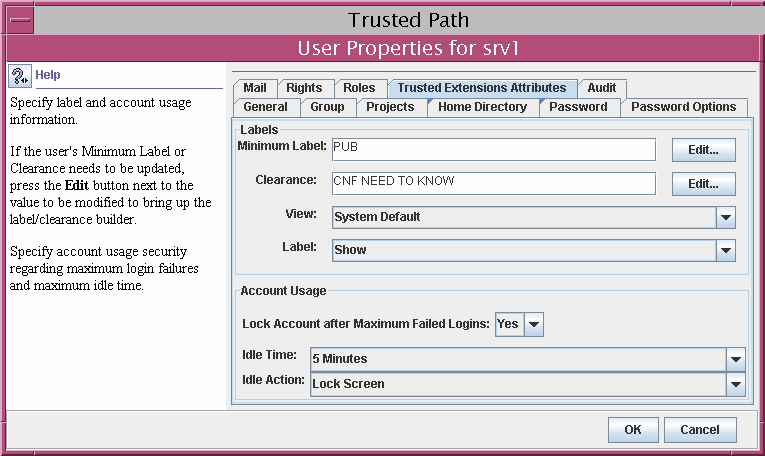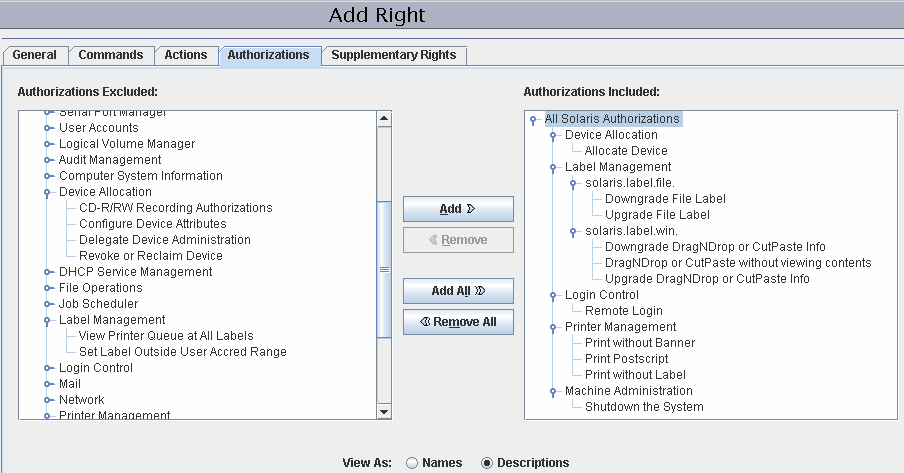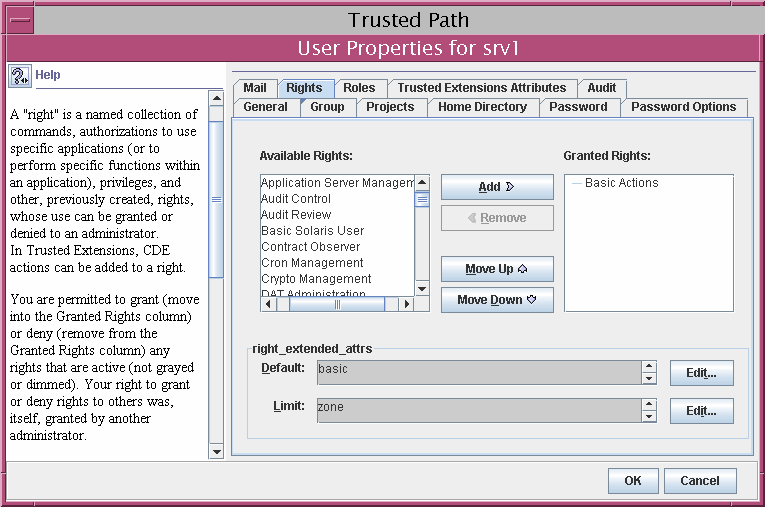| Skip Navigation Links | |
| Exit Print View | |

|
Oracle Solaris Trusted Extensions Administrator's Procedures Oracle Solaris 10 8/11 Information Library |
| Skip Navigation Links | |
| Exit Print View | |

|
Oracle Solaris Trusted Extensions Administrator's Procedures Oracle Solaris 10 8/11 Information Library |
1. Trusted Extensions Administration Concepts
2. Trusted Extensions Administration Tools
3. Getting Started as a Trusted Extensions Administrator (Tasks)
4. Security Requirements on a Trusted Extensions System (Overview)
5. Administering Security Requirements in Trusted Extensions (Tasks)
6. Users, Rights, and Roles in Trusted Extensions (Overview)
7. Managing Users, Rights, and Roles in Trusted Extensions (Tasks)
Customizing the User Environment for Security (Task Map)
How to Modify Default User Label Attributes
How to Modify policy.conf Defaults
How to Configure Startup Files for Users in Trusted Extensions
How to Lengthen the Timeout When Relabeling Information
How to Log In to a Failsafe Session in Trusted Extensions
Managing Users and Rights With the Solaris Management Console (Task Map)
How to Modify a User's Label Range in the Solaris Management Console
How to Create a Rights Profile for Convenient Authorizations
How to Restrict a User's Set of Privileges
How to Prevent Account Locking for Users
How to Enable a User to Change the Security Level of Data
How to Delete a User Account From a Trusted Extensions System
Handling Other Tasks in the Solaris Management Console (Task Map)
8. Remote Administration in Trusted Extensions (Tasks)
9. Trusted Extensions and LDAP (Overview)
10. Managing Zones in Trusted Extensions (Tasks)
11. Managing and Mounting Files in Trusted Extensions (Tasks)
12. Trusted Networking (Overview)
13. Managing Networks in Trusted Extensions (Tasks)
14. Multilevel Mail in Trusted Extensions (Overview)
15. Managing Labeled Printing (Tasks)
16. Devices in Trusted Extensions (Overview)
17. Managing Devices for Trusted Extensions (Tasks)
18. Trusted Extensions Auditing (Overview)
19. Software Management in Trusted Extensions (Tasks)
A. Quick Reference to Trusted Extensions Administration
In Trusted Extensions, you must use the Solaris Management Console to administer users, authorizations, rights, and roles. To manage users and their security attributes, assume the Security Administrator role. The following task map describes common tasks that you perform for users who operate in a labeled environment.
|
You might want to extend a user's label range to give the user read access to an administrative application. For example, a user who can log in to the global zone could then run the Solaris Management Console. The user could view, but not not change the contents.
Alternatively, you might want to restrict the user's label range. For example, a guest user might be limited to one label.
Before You Begin
You must be in the Security Administrator role in the global zone.
Use a toolbox of the appropriate scope. For details, see Initialize the Solaris Management Console Server in Trusted Extensions in Oracle Solaris Trusted Extensions Configuration Guide.
A password prompt might be displayed.

You can also lower the minimum label.
Where site security policy permits, you might want to create a rights profile that contains authorizations for users who can perform tasks that require authorization. To enable every user of a particular system to be authorized, see How to Modify policy.conf Defaults.
Before You Begin
You must be in the Security Administrator role in the global zone.
Use a toolbox of the appropriate scope. For details, see Initialize the Solaris Management Console Server in Trusted Extensions in Oracle Solaris Trusted Extensions Configuration Guide.
A password prompt might be displayed.
For the step-by-step procedure, see How to Create or Change a Rights Profile in System Administration Guide: Security Services.
In the following figure, the Authorizations Included window shows the authorizations that might be convenient for users.

Allocate Device – Authorizes a user to allocate a peripheral device, such as a microphone.
By default, Oracle Solaris users can read and write to a CD-ROM. However, in Trusted Extensions, only users who can allocate a device can access the CD-ROM drive. To allocate the drive for use requires authorization. Therefore, to read and write to a CD-ROM in Trusted Extensions, a user needs the Allocate Device authorization.
Downgrade DragNDrop or CutPaste Info – Authorizes a user to select information from a higher-level file and place that information in a lower-level file.
Downgrade File Label – Authorizes a user to lower the security level of a file
DragNDrop or CutPaste without viewing contents – Authorizes a user to move information without viewing the information that is being moved.
Print Postscript – Authorizes a user to print PostScript files.
Print without Banner - Authorizes a user to print hard copy without a banner page.
Print without Label – Authorizes a user to print hard copy that does not display labels.
Remote Login – Authorizes a user to remotely log in.
Shutdown the System – Authorizes a user to shut down the system and to shut down a zone.
Upgrade DragNDrop or CutPaste Info – Authorizes a user to select information from a lower-level file and place that information in a higher-level file.
Upgrade File Label – Authorizes a user to heighten the security level of a file.
For assistance, see the online help. For the step-by-step procedure, see How to Change the RBAC Properties of a User in System Administration Guide: Security Services.
Example 7-5 Assigning a Printing-Related Authorization to a Role
In the following example, the Security Administrator allows a role to print jobs without labels on body pages.
In the Solaris Management Console, the security administrator navigates to Administrative Roles. She views the rights profiles that are included in a particular role, then ensures that the print-related authorizations are contained in one of the role's rights profiles.
Site security might require that users be permitted fewer privileges than users are assigned by default. For example, at a site that uses Trusted Extensions on Sun Ray systems, you might want to prevent users from viewing other users' processes on the Sun Ray server.
Before You Begin
You must be in the Security Administrator role in the global zone.
Use a toolbox of the appropriate scope. For details, see Initialize the Solaris Management Console Server in Trusted Extensions in Oracle Solaris Trusted Extensions Configuration Guide.
A password prompt might be displayed.

By removing the proc_session privilege, you prevent the user from examining any processes outside the user's current session. By removing the file_link_any privilege, you prevent the user from making hard links to files that are not owned by the user.
 | Caution - Do not remove the proc_fork or the proc_exec privilege. Without these privileges, the user would not be able to use the system. |

Trusted Extensions extends the user security features in the Solaris Management Console to include account locking. Turn off account locking for users who can assume a role.
Before You Begin
You must be in the Security Administrator role in the global zone.
Use a toolbox of the appropriate scope. For details, see Initialize the Solaris Management Console Server in Trusted Extensions in Oracle Solaris Trusted Extensions Configuration Guide.
A password prompt might be displayed.
A regular user or a role can be authorized to change the security level, or labels, of files and directories. The user or role, in addition to having the authorization, must be configured to work at more than one label. And, the labeled zones must be configured to permit relabeling. For the procedure, see How to Enable Files to be Relabeled From a Labeled Zone.
 | Caution - Changing the security level of data is a privileged operation. This task is for trustworthy users only. |
Before You Begin
You must be in the Security Administrator role in the global zone.
The following authorizations enable a user to relabel a file:
Downgrade File Label
Upgrade File Label
The following authorizations enable a user to relabel information within a file:
Downgrade DragNDrop or CutPaste Info
DragNDrop or CutPaste Info Without Viewing
Upgrade DragNDrop or CutPaste Info
For assistance, use the online help. For a step-by-step procedure, see How to Change the RBAC Properties of a User in System Administration Guide: Security Services.
When a user is removed from the system, you must ensure that the user's home directory and any objects that the user owns are also deleted. As an alternative to deleting objects that are owned by the user, you might change the ownership of these objects to a valid user.
You must also ensure that all batch jobs that are associated with the user are also deleted. No objects or processes belonging to a removed user can remain on the system.
Before You Begin
You must be in the System Administrator role.
Use a toolbox of the appropriate scope. For details, see Initialize the Solaris Management Console Server in Trusted Extensions in Oracle Solaris Trusted Extensions Configuration Guide.
A password prompt might be displayed.
You are prompted to delete the user's home directory and mail files. When you accept the prompt, the user's home directory and mail files are deleted in the global zone only.
Note - You are responsible for finding and deleting the user's temporary files at all labels, such as files in /tmp directories.